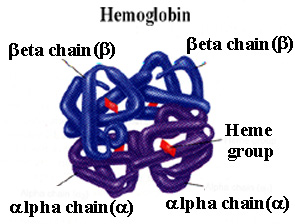
|
Oxygen Transport |
On equilibration with alveolar air, (PO2 = 104mmHg), 0.3ml O2 per 100ml of plasma is physically dissolved. This low concentration is related to the low solubility of oxygen. This is clearly not adequate for tissue oxygeneation when one considers that at rest, the oxygen consumption averages 250ml/min. On the other hand the presence of red blood cells and specifically of haemoglobin, increases the amount of oxygen in oxygenated blood to around 20%. The bulk of the oxygen is transported by reversible chemical combination with haemoglobin.
The haemoglobin molecule is made up of two pairs of globin chains, 2 alpha-like chains (
z or a) and two non alpha-like chains (e or g or d or b), each associated with one heme group. Each globin chains is coded by at least one gene. Thus on chromosome #11 one finds a epsilon, two gamma, one delta and one beta gene while on chromosome #16, one finds one zeta and two alpha genes.
|
|
|